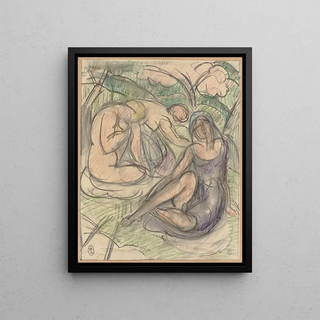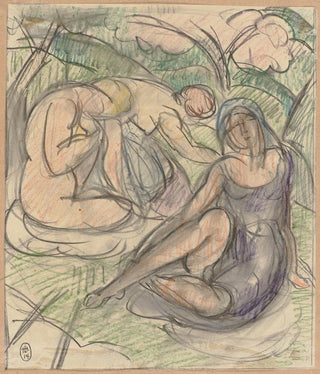Art print | Three women - Hermann Lismann Source: Reproduction | Trois femmes - Hermann Lismann


View from behind

Frame (optional)
The canvas "Three Women" by Hermann Lismann stands as a true ode to femininity, capturing the essence of intimacy and human relationships through the lens of art. This piece, imbued with delicacy and depth, invites the viewer to immerse themselves in a universe where emotions and interactions come to life. The depiction of these three female figures, each bearing a unique expression, evokes a story that is both personal and universal, making this artwork timeless and captivating. By contemplating this art print, one feels a surge of curiosity and a desire to discover the stories these women might share.
Style and uniqueness of the work
Lismann's style is distinguished by a subtle harmony between realism and impressionism, where nuances of color and play of light intertwine to give life to his subjects. In "Three Women," the contours of the figures are delicately sketched, while the backgrounds blend into a soft, dreamlike atmosphere. The expressions of the women, whether of melancholy, joy, or contemplation, are highlighted by brushstrokes that seem to vibrate with emotion. This painting does not merely depict figures; it tells a story, a palpable connection between these women that transcends time and space. The composition is carefully thought out, with each element contributing to the visual balance, while leaving room for the viewer's imagination.
The artist and his influence
Hermann Lismann, an emblematic figure of his era, managed to leave a mark on the art world with his unique vision and refined technique. Influenced by the great masters of painting, he developed a personal style that is his own, blending tradition and modernity. His work is characterized by meticulous attention to detail and a capacity to capture the very essence of his subjects. Lismann was also a keen observer of his time, incorporating contemporary elements into his creations while honoring the classics. His contribution to art extends beyond his canvases, also encompassing his role as a teacher and mentor to many emerging artists. Through his works, he managed to inspire generations

Matte finish

View from behind

Frame (optional)
The canvas "Three Women" by Hermann Lismann stands as a true ode to femininity, capturing the essence of intimacy and human relationships through the lens of art. This piece, imbued with delicacy and depth, invites the viewer to immerse themselves in a universe where emotions and interactions come to life. The depiction of these three female figures, each bearing a unique expression, evokes a story that is both personal and universal, making this artwork timeless and captivating. By contemplating this art print, one feels a surge of curiosity and a desire to discover the stories these women might share.
Style and uniqueness of the work
Lismann's style is distinguished by a subtle harmony between realism and impressionism, where nuances of color and play of light intertwine to give life to his subjects. In "Three Women," the contours of the figures are delicately sketched, while the backgrounds blend into a soft, dreamlike atmosphere. The expressions of the women, whether of melancholy, joy, or contemplation, are highlighted by brushstrokes that seem to vibrate with emotion. This painting does not merely depict figures; it tells a story, a palpable connection between these women that transcends time and space. The composition is carefully thought out, with each element contributing to the visual balance, while leaving room for the viewer's imagination.
The artist and his influence
Hermann Lismann, an emblematic figure of his era, managed to leave a mark on the art world with his unique vision and refined technique. Influenced by the great masters of painting, he developed a personal style that is his own, blending tradition and modernity. His work is characterized by meticulous attention to detail and a capacity to capture the very essence of his subjects. Lismann was also a keen observer of his time, incorporating contemporary elements into his creations while honoring the classics. His contribution to art extends beyond his canvases, also encompassing his role as a teacher and mentor to many emerging artists. Through his works, he managed to inspire generations






